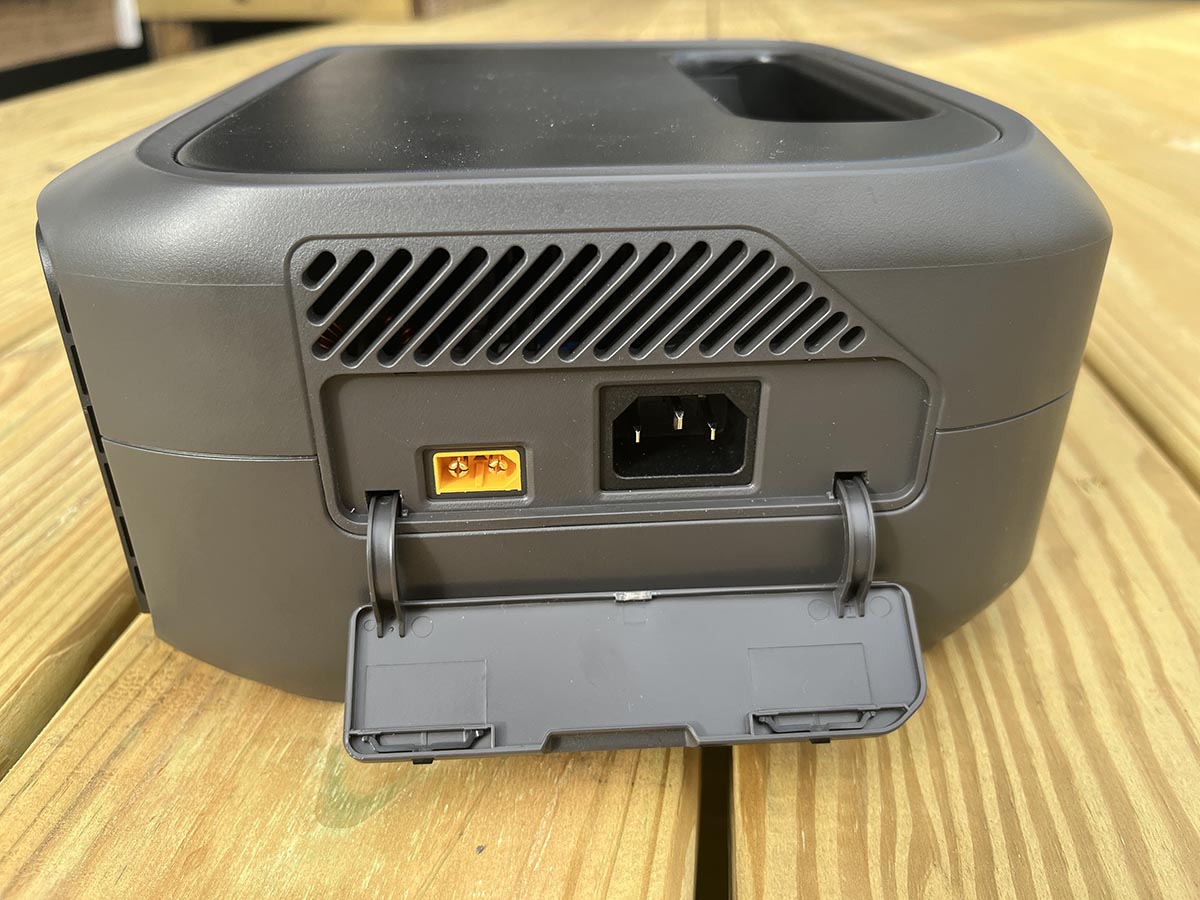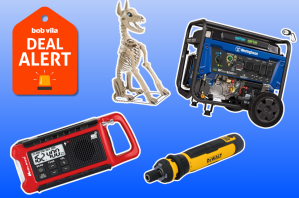

We may earn revenue from the products available on this page and participate in affiliate programs. Learn More ›
When we need to stay connected, a backup power source like the EcoFlow River 3 Portable Power Station offers a measure of security. EcoFlow is a global company headquartered in San Francisco offering battery power solutions including portable power, home backup, and off-grid products. I previously tested some of the larger EcoFlow Delta Series power stations, which impressed me with sturdy build quality and numerous conveniences, so I was looking forward to giving the River 3 a try. In my month-long test, the EcoFlow River 3 proved to be a tough, fast-charging competitor that had dozens of uses around the house and in camp. In this EcoFlow River 3 review, I’ll share my observations from testing, and why I think it is one of the best compact power stations on the market.
EcoFlow River 3 Portable Power Station: At a Glance
Our rating: 4.7/5
Top Pick

EcoFlow River 3 Portable Power Station
| EcoFlow River 3 Specs | |
| Capacity | 245 Wh |
| Battery Type | Li-Fe-PO4 |
| Outlets | (2) AC, (2) USB-A, (1) USB-C, (1) DC car |
| Inputs | AC, DC/Solar |
| Dimensions | 10 x 8.3 x 4.4 inches |
| Weight | 7.8 pounds |
| Price | $179 |
Buy the EcoFlow River 3 Portable Power Station at:
Testing the EcoFlow River 3 Portable Power Station
The EcoFlow River 3 is a small portable power station suitable for home, office, or travel. Its lithium iron phosphate battery bank has a 245-watt hour capacity and 300-watt maximum output, which is sufficient for charging handheld electronics and powering small appliances. The unit is compatible with the EcoFlow mobile app, which provides remote monitoring and customized settings. Small enough to fit inside a daypack and a tad under 8 pounds, it is conveniently sized for outdoor adventures, but it’s also smart enough to serve as an uninterrupted power supply for sensitive electronic equipment.
Over 4 weeks, I tested the EcoFlow River 3 several different ways. One week it served as the sole power source to charge my phone, laptop, and a few other small cordless devices. Then I brought the River 3 and a 110-watt solar panel on a weekend camping trip to serve as a charging hub for 8 people and our devices. Finally, I set it up as an uninterrupted power supply (UPS) for my tankless gas water heater. Throughout the month-long test, the River 3 repeatedly proved its worth as a portable, flexible, and easy-to-use remote power source.
| What We Like | What We Don’t Like |
| Compact and lightweight for easy transport | No LED lights on the base model* |
| Outlets to charge or run most devices | Only 1 3-prong AC outlet on the base model* |
| Recharges very quickly | |
| Less than 20-microsecond auto transfer |
Smart Features Support Different Use Cases

One of the things that make the EcoFlow River 3 truly stand out is its technical superiority. Other power stations on the market incorporate a basic battery, inverter, and charge control system, but the River 3 is infused with advanced features. It features state-of-the-art gallium nitride (GaN) components that enable faster charging, longer run time for low-wattage appliances and less heat loss than the industry standard. Some of the extra benefits include a 30 percent smaller overall size because less space is required for cooling and quieter operation. Another feature is the X-Boost system, which delivers higher wattage (up to 600 watts) than the rating of the power station (300 watts), to accommodate high-draw appliances.
Right out of the box, the River 3 appeared similar to other power stations. It included a pair of USB-A ports, a USB-C, a DC car outlet, a 3-prong AC outlet, and a 2-prong AC outlet. The two input ports allow AC charging via wa all outlet or gas generator, or DC charging from a solar panel or car outlet. To tap into the full range of control and functionality, I downloaded the EcoFlow mobile app and added my River 3 to my home WiFi network. With the app, I was able to update the station’s firmware, set custom charge and discharge limits, schedule charging by power source, and lots of other helpful tasks. For instance, when I installed it as a UPS, I used the app to switch the AC outlet timeout setting to “never” so that it would continuously function.

Dependable Power Wherever You Go
The River 3’s compact size and built-in handle makes it easy to pack up and go without really having to plan for it. It took about an hour to fully charge from a wall outlet before it was ready to grab and go. For the camping trip, I just slid it under the back seat of the truck. As a charging port, both in camp and on my desk at home, I plugged three different charging cables into the USB ports and left the AC outlets open for any charger types I might have missed.
From a full charge, the River 3 kept my phone and laptop running for a whole week without a problem. At the end of the week, after charging the laptop 3 times and the phone 4 times, the power station still had a 57 percent charge. Because my camping friends started out with full charges on their devices, our whole group only used 21 percent of the full capacity between Friday evening and Sunday morning.
As a mobile charging station, the River 3 was more than adequate for our needs, and could probably support a full week in the woods, especially if supplemented by solar. When I finally ran the charge down below 10 percent, I connected the 110-watt solar panel on a brilliantly sunny day, and it recharged fully in a little more than 3 hours.
To test the River 3 as a UPS for my tankless gas water heater, and to try out the app settings, I plugged the heater’s igniter cord into the power station, and the power station into the wall. In the app, I had already set the unit’s AC outlet to never time out. I also adjusted the upper charge limit to 80 percent, since I wouldn’t want it to store a full charge for months on end.
I tested the system by turning off the circuit breaker for the water heater and after 5 minutes turned on the closest hot water spigot. It is supposed to switch over in less than 20 microseconds, and as far as I could tell, it worked perfectly. Since my gas water heater only uses a tiny amount of electricity to trigger the flame that actually does the heating, this power station could do that for weeks on a single charge.

Durable Construction for Real World Conditions
I also observed a few points with regard to the River 3’s overall build quality. The exterior of the power station has very few parts that could break. The handle is integrated with the body; there are no wheels; and the buttons and covers have a snug, smooth fit. A lithium-iron phosphate battery pack forms the core of the unit. This battery chemistry offers a longer working life than lithium-ion, up to 3,000 charge cycles, as well as a faster charge rate, higher discharge rate, and outstanding safety.
The battery pack comes with an IP54 water- and dust-resistant rating, meaning that only the battery pack itself is “waterproof,” not the outlets, LCD display, or other components. The brand also indicates that the shell is fire retardant and that the unit has survived a 3.3-foot drop test. Under normal, not especially careful treatment, it did great. In camp, I kept it under a pavilion where it was exposed to the ambient air conditions, but not to precipitation or direct sunlight. My only reservation about consistent use in outdoor or dusty environments is that neither the USB ports nor the AC outlets are covered. The Car outlet and the input ports are covered.

Versatile and Dependable…and Worth Every Penny
The EcoFlow River 3 incorporates thoughtful design and durable construction with state-of-the-art technology. Compared to similarly powerful models from other popular brands, it comes in at a mid-level price, but offers top-end technical features that boost its overall performance and value. For those interested in the advanced features, it’s one of the best values on the market.
The two standout features here are the UPS capability and the streamlined user interface of the app. The River 3 only offers two AC outlets and one of those is a 2-prong, but it is a fair match for the typical tasks you might use it for: keeping small low-draw appliances going in an emergency or as a portable charging base. As I hinted earlier, any brand can slap together a battery backup, but EcoFlow leads the market when it comes to customizable options and control.
Buy the EcoFlow River 3 Portable Power Station at:

Product Comparisons
| EcoFlow River 3 | Anker Solix C300 DC See our review. | Jackery Explorer 300 | Bluetti AC2A | Segway Lumina 500 | |
| Capacity | 245 Wh | 288 Wh | 293 Wh | 204.8 Wh | 512 Wh |
| Battery | Li-Fe-PO4 | Li-Fe-PO4 | Li-ion | Li-Fe-PO4 | Li-Fe-PO4 |
| Outlets | (2) AC, (2) USB-A, (1) USB-C, (1) DC car | (2) USB-A, (4) USB-C, (1) DC car | (2) AC, (2) USB-A, (1) USB-C, (1) DC car | (2) AC, (2) USB-A, (1) USB-C, (1) DC car | (2) AC, (4) USB-A, (2) USB-C, (1) DC car |
| Inputs | AC, DC/Solar | USB-C2, USB-C3, Solar, Car | AC/DC/Solar, USB-C | AC, DC/Solar | AC, DC/Solar |
| Lights? | No | Yes | No | No | Yes |
| Dimensions | 10 x 8.3 x 4.4 inches | 4.9 x 4.7 x 7.9 inches | 9.1 x 5.2 x 7.8 inches | 9.8 x 6.1 x 6.8 inches | 11.3 x 9.6 x 7.2 inches |
| Weight | 7.8 pounds | 6.17 pounds | 7.1 pounds | 7.9 pounds | 15.9 pounds |
| Price | $179.00 | $149.99 | $259.00 | $149.00 | $299.99 |

So, is the EcoFlow River 3 Portable Power Station right for you?
The EcoFlow River 3 Portable Power Station is designed as a compact charging and power backup solution for home, office, or travel. It is lightweight, compact, and easy to store or transport. But if you’re only looking for a portable battery charger, you may think that the price is a bit much, especially as it doesn’t include such sought-after features as an LED light bar or an array of 3-prong outlets. It may not be for everyone.
In my tests, the best features were technical. I found the controls, both onboard and in the mobile application, to be intuitive and easy to navigate. Even those with only a passing understanding of electrical terms will be up and running in no time. Most importantly, they offered an easy way to keep things up and running when the situation goes sideways, as in a major storm or extended power outage. A little bit of electricity goes a long way in those situations, and this unit gives you the power to deploy it when and where you need it.
Meet the Tester
Mark Wolfe is a writer and product tester with a background in the green industry. He’s also an avid DIYer who lives in an older home. When he isn’t testing tools, generators, and outdoor power equipment, he spends his time upgrading, repairing, and replacing anything and everything in his home, yard, and garden.
